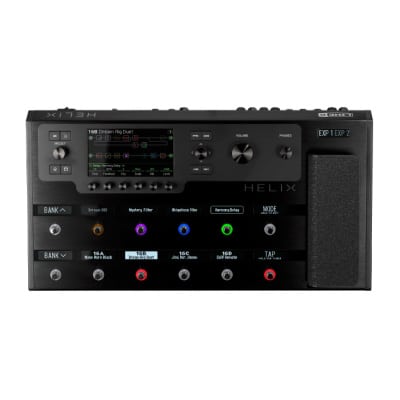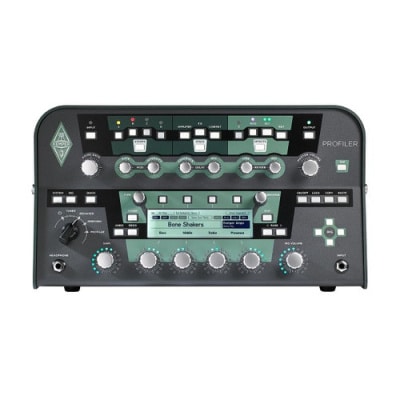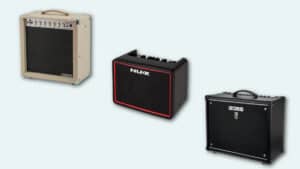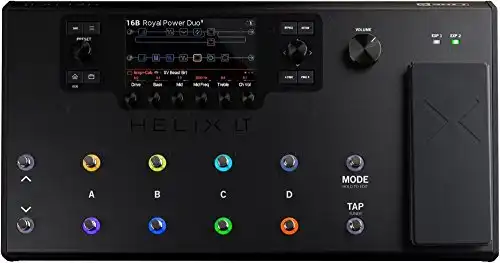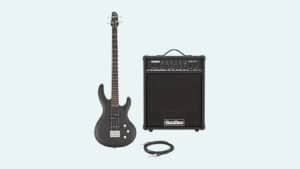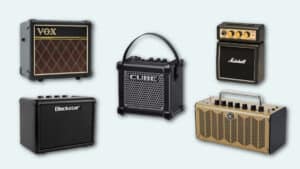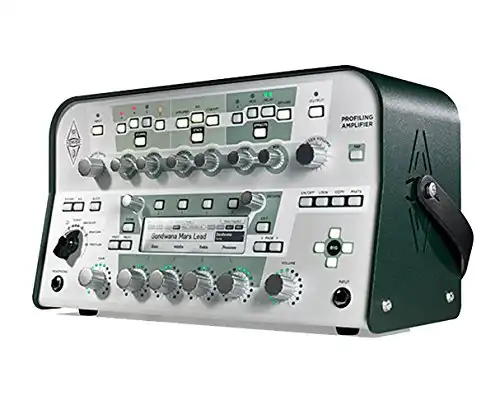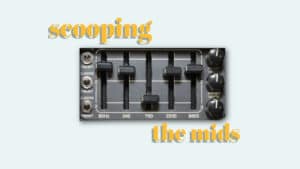The rivalry between Kemper and Helix has been going on for seven years.
And at the moment, these amps command the highest demand in the market, so it’s quite normal for various debates to spark up.
While those two amps can produce good sound with superb tones, knowing the difference between the Line 6 Helix and the Kemper Profiler can be difficult.
If you’re planning to get a new amp, you might find it challenging to make a call. To help you out, I’m going to dive deep into each amp so you can be confident you’ve found the one that best suits your needs.
Helix vs Kemper Overview
| Specification | Helix | Kemper |
| Sound | Tones have a certain signature | Unique and realistic tones that are similar to real guitar amps |
| Display | A large display unit, measuring 6.2’’ | A rather small display unit |
| Effects | 200 effects | 80 effects |
| Types of Effects | Synth filter, reverb, distortion, delay, modulation, limiter, pitch shift | Volume, modulation, wah, gain, pitch, ambience |
| Presets | 1024 | 999 profiles |
| Output | ¼” send, XLR | Two ¼’’ monitor, two ¼’’ main, two XLR main |
| Input | ¼” guitar, ¼” return, XLR mic | ¼ ” instrument input, ¼” return |
| Modeling | More than 100 amps | The total number is not defined because a user can add his own profiles |
| Pedals | In-built expression pedal | It has to be connected to Kemper Remote to extend the functionalities |
Line 6 Helix
Constructed as a pedalboard, Helix features a built-in expression pedal, multiple footswitches, and a joystick encoder. As a result, you can easily organize and modify various sounds with your feet due to the footswitches. And while Helix packs footswitches, guitarists can use it as a desktop unit if they are editing for long periods.
That said, assigning functionalities to the control pedal and streamlining various tasks is quite easy. A single patch can contain two functionalities. To switch between one patch to the next, you need to move the pedal forward with your toes.
Helix also comes with a digital scribble strip that shows you the functionality of each footswitch by displaying the parameters that are assigned to each footswitch. Since it displays big characters, you can easily read the displayed character, even if you are far away from the unit.
To give you access to the main unit, the Line 6 Helix comes with various types of controls. Every encoder has a switch that lets you accomplish a certain functionality. For instance, the encoder that’s located on the left side of the main unit is quite effective in scrolling through different presets.
Moreover, Helix has two performance modes that make it easier for you to choose between various sets of patches.
Creatives always rely on it as they are modifying sound, composing new stuff, and practicing for multiple gigs.
Apart from that, Helix simultaneously produces effected and dry tones, giving you a wide variety of options to experiment with.
The Line 6 Helix LT guitar processor features the same advanced HX Modeling technology found in the Helix Floor and Helix Rack processors.
Unlike the previous models, the Line 6 Helix packs an advanced processor that is capable of handling three-dimensional tones, producing a wide array of various tones. Thanks to the four parallel signal paths, you can use dual signal chains to create unique patches.
If you want to get a compressed signal with original transients, run a clean path, side by side, with a compressed path.
Featuring a user-friendly operating system, a color-coding system, and a neat layout, Helix makes it easier for you to edit and modify sounds directly from the main unit.
Thanks to the input and output connections, this amp has multiple signal processing paths that can handle analog and digital signals. Thanks to multiple signal paths, you can easily come up with dynamic patches. For starters, the guitar input jack is compatible with various impedances.
On top of that, Helix also comes with an aux-in, which is designed for both bass guitars and active guitars.
The amp also features an XLR mic input and various analog outputs.
What I Like
- Built-in expression pedal
- It can simultaneously process effected tones and dry tones
- Color coding system for easier interpretation
- A wide array of effects
What I Don’t Like
- It might be challenging to add your own profile to the main unit
- Tones have a certain signature
Kemper Profiler
Kemper comes with a performance mode and a browse mode. The performance mode is designed for studio sessions and live performances, offering you various settings that help you create unique setups.
The browse mode lets you change profiles and effects as you are playing. Due to this, it is ideal for studio sessions, giving you different options which take your creativity to another level.
Kemper also has 125 slot for saving setups, each slot accommodating five settings. For instance, if you are playing in a band, you can save your favorite tones on the performance setups and use them during band performances.
Moreover, Kemper Profiler packs various output and input connections for extending the functionalities of the rig to get different results.
This amp is compatible with other types of gear such as the Kemper remote, which complements the whole setup, giving you more functionalities to work with.
Designed to function as a pedalboard, the Kemper remote can be configured with the Profiler, making it easier for you to switch between various settings. Kemper Remote features a built-in tuner, tempo delay, and looper.
When it comes to sound, Kemper Profiler is effective in capturing electrical signals and simulating physical characteristics of amps to give you tones that are as authentic as possible.
The Kemper Profiler is the all-in-one solution for electric guitar and bass. It's a multi-effect-processor, preamp and optional poweramp. Due to its high connectivity it fits perfect to all purposes, no matter if you're playing live, at home or in the studio.
What I Like
- Superb tones
- Different amplifier modes such as the performance mode and browse mode
- Offers you 125 slots for saving setups
- A sonic capture technology for producing realistic tones
What I Don’t Like
- It doesn’t feature in-built pedals
Features Face To Face
User Friendliness
In terms of ease of use, Helix comes with a user-friendly front panel. Kemper, on the other hand, has a cluttered front panel, featuring multiple controls, multiple knobs, and switches. As a result, it might take you a long period of time to get used to it.
Buttons and controls on Helix can be used to modify different settings easily. Not to mention, they have a satisfying click.
When it comes to the I/O layout, both amps have layouts that are almost similar to one other. However, unlike Kemper’s I/O, Helix comes with word clock and variant outputs, giving it a competitive edge over Kemper.
Apart from that, Helix I/O layout is more organized and neater, as compared to Kemper’s I/O layout. Since the outputs are lined up in an orderly manner, it becomes easier to find a certain output.
User Friendliness Winner: Helix
Tone Modelling
For most guitarists, tone modeling can be a deal-breaker. Well, Kemper tones lie more on the vacuum tube amplifier side, producing an original and unique classic sound.
And instead of using a vacuum tube amplifier that might not be reliable, Kemper lets you enjoy similar tones in a more advanced manner. Additionally, Kemper packs 200 profiles, giving you a wide array of options to choose from.
The Helix 6 has a digital amplification that is quite reliable and versatile. However, it is not as unique as what is offered by Kemper. And while the tone modeling of both amps are almost similar, Kemper has a competitive edge over the Helix 6.
Tone Modelling Winner: Kemper
The Kemper Profiler is the all-in-one solution for electric guitar and bass. It's a multi-effect-processor, preamp and optional poweramp. Due to its high connectivity it fits perfect to all purposes, no matter if you're playing live, at home or in the studio.
Display Unit
Kemper packs a small display unit, giving you user interface access. While the display unit can help you perform various tasks, it is a little bit outdated as compared to other models.
Constructed with a 6.2” display unit, the Line 6 Helix makes it easier for you to read everything that is displayed on the user interface. Not to mention, information is always displayed in an orderly manner.
And since the display is color-coded for easier interpretation, you’ll have an easy time accessing different data. Thanks to the scratch-resistant material, the display unit can last for a long period of time.
Display Unit Winner: Helix
The Line 6 Helix LT guitar processor features the same advanced HX Modeling technology found in the Helix Floor and Helix Rack processors.
Profiling
The two products will offer you various profiles, but Kemper features advanced settings which take profiling to a whole new level. Not to mention, Kemper makes it easier for you to save up to 1000 profiles that might come in handy whenever you try to replay your favorites.
Kemper is a suitable option for those who love creating their own profiles. Featuring a wide array of options for extracting different types of tones, Kemper makes it easier for you to get unique profiles.
Since profiles are readily available on various websites, Kemper’s design gives you various options for adding profiles. While such profiles can offer you some versatility, the built-in profiles have a better quality than the ones downloaded from the internet.
Profiling Winner: Kemper Profiler
Effects
Kemper packs a wide array of effects, offering you multiple delays, modulations, and reverbs to play with. An example of a superb effect by Kemper is the pitch shifter, which lets you modify tunings in a split second without struggling with retunes.
Thanks to the frequent Kemper updates, you’ll get a chance to try out new effects after a certain period
Designed to handle complex signal routing, Helix has a competitive edge when it comes to multi-effects. With the Helix 6, you can easily bypass the compressor with reverbs.
And by distorting delays over a single clean tone, you’ll get a unique sound that’s almost similar to the post-rock sound. It’s also worthwhile to note that Helix plays up to nine effects at the same time. Clearly, Helix is suitable for guitarists who love wet patches.
Multi-Effects Winner: Helix
Sound Quality
Kemper wasn’t designed to produce a single sound or tone quality. Instead, it relies on a sonic capture proprietary technology, which processes the properties of multiple amplifiers to extract the exact tones. As a result, it reproduces any tone you might create by making it sound real.
If a profile is captured perfectly, Kemper will sound good. In some instances, it might be challenging to know whether the tone was produced by a guitar amp or the profiler. Comparatively, the results might not be satisfying when a bad tone is created.
Helix, on the other hand, hasn’t evolved from traditional profiling procedures, where the manufacturer profiles various amplifiers and then features them in the product. Due to this, some tones have a top-end fizz.
Sound Quality Winner: Kemper
Stand Out Features
Kemper
- Unique profiles: The ability to add profiles to the main makes it easier for you to experiment with different tunes.
- Sonic capture technology: Kemper Profiler was designed to reproduce tones that are almost similar to the tones produced by real guitar amps.
- Combining profiles and effects: The Kemper Profiler makes it easier to use profiles and effects simultaneously to create something unique.
- Amplifier modes: Due to the performance mode and browse mode, you can easily use the Kemper profiler in different scenarios. The performance mode is ideal for live performances, while the browse mode is suitable for studio setups.
- Direct output option: The direct output option is quite effective in bypassing profiles and effects to produce a clean guitar signal. This feature might come in handy whenever you are trying to edit a distorted signal, so that you can get a clean guitar signal.
Line 6 Helix
- A large display unit: Since the display unit is 6.2”, you’ll get insight into various parameters and settings. The display unit is very visible, making it easier for you to read characters while performing.
- A built-in expression pedal: With the pedal, you can easily access various functionalities for modifying and accessing presets.
- Handles four parallel signal paths simultaneously: To emulate unique tones, the Line 6 Helix lets you use various effects at the same time.
Conclusion: Helix vs Kemper: Which is The Best for You?
Go for the Line 6 Helix if:
- You love experimenting with multiple tones by using different effects simultaneously.
- You are a beginner who wants to work with a wide array of profiles.
- You prefer working with an expression pedal.
- You are looking for an amp with a user-friendly user interface.
- You want to work with a product that reproduced refined tones.
The Kemper Profiler may be your best bet if:
- You want to create your own unique profiles.
- You love downloading profiles, which are created by other engineers and artists, from the internet.
- You want to combine profiles and effects to create unique tones.
- You are looking for an amp that reproduces tones that are similar to tones, which are reproduced by a real amp.
- You are more experienced with profiles.
- You are looking for a product that can help you edit distorted signals.

